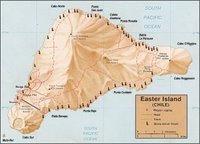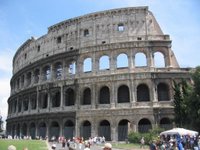Easter Island (Moai)
 |  |
 |
Easter Island
Location: 27 07' 10" S 109 20' 40" W (Copy&Paste in Google Earth)
Wikipedia: Easter Island , Moei
Easter Island is an island in the south Pacific Ocean belonging to Chile. Located 3,600 km (2,237 statute miles) west of continental Chile and 2,075 km (1,290 statute miles) east of Pitcairn Island, it is the most isolated inhabited island in the world. The island is approximately triangular in shape, with an area of 163.6 km² (63 sq. miles), and a population of 3,791 (2002 census), 3,304 of which live in its capital city Hanga Roa. The island is famous for its numerous moai, thousand-year-old (approx.) stone statues now located along the coastlines. Modern Easter Island has virtually no trees.

Moai are statues carved of compressed volcanic ash on Rapa Nui (Easter Island). The statues are all monolithic, that is, carved in one piece. However, less than about one-fifth of the statues that were moved to ceremonial sites and then erected once had red stone cylinders pukau placed on their heads. These "topknots," as they are often called, were carved in a single quarry known as Puna Pau. About 95% of the 887 moai known to date were carved out of compressed volcanic ash at Rano Raraku, where 394 moai still remain visible today. Recent GPS mapping in the interior will certainly add additional moai to that count. The quarries in Rano Raraku appear to have been abandoned abruptly, with many incomplete statues still in situ. However, the pattern of work is very complex and is still being studied. Practically all of the completed moai that were moved from Rano Raraku and erected upright on ceremonial platforms were subsequently toppled by native islanders in the period after construction ceased.
Although usually identified as "heads" only, the moai are actually one piece figures with heads and truncated torsos.
The most widely-accepted theory is that the statues were carved by the Polynesian colonizers of the island beginning by about A.D. 1000-1100. In addition to representing deceased ancestors, the moai, once they were erect on ceremonial sites, may also have been regarded as the embodiment of powerful living chiefs. They were also important lineage status symbols.



























